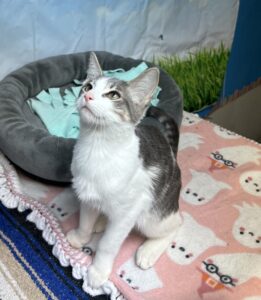Being allergic doesn’t necessarily mean you can’t have a pet or that you must give up the one you already have. You can solve this problem by learning more about minimizing pet-related allergies and making some minor adjustments.
Allergic reactions are caused by allergens–substances usually invisible to the human eye. The allergens your pet carries are associated with its skin, hair follicles and saliva. Dander–a naturally-occurring combination of skin cells and saliva that the pet is continually shedding–is most often the cause of pet allergies. It is the protein of this dander that causes the reactions. Dander imbeds itself in the carpeting, furniture and draperies and remains in the environment to cause reactions. “Fel d 1”, the cat allergen, is the major cause of allergic reactions to cats. During a cat’s self-cleaning process, Fel d 1 protein in the saliva is deposited on the fur. It is also produced by sebaceous glands–the skin glands that secrete the oils that keep the skin and hair sleek and shiny. Male cats usually produce more allergen than females. Proteins in the urine of cats will also trigger allergic reactions.
Some animals seem more tolerable than others because they shed fewer allergens. Unfortunately, there are no non-allergic animals. It is also true that the length of hair does not alter the animal’s allergen level. Within any given breed, or even litter, you may find animals that you can tolerate better than others.
Allergies are usually cumulative. Since the allergic person is sensitive to more than one thing, it is the Total Allergen Level that causes a reaction. Whether or not a person has symptoms depends on how many allergens are in the environment at the same time. An individual who is allergic to animals may exhibit no noticeable symptoms when the total exposure is below his allergy threshold level. The trouble begins when there are enough allergens in the environment to exceed this level. The goal is to minimize exposure to airborne allergens that exceed tolerance thresholds and trigger attacks.
No more cats sleeping on the bed.
Sorry, this is a small price to pay for allergy relief. If you get your symptoms under control by all means invite them back, but give yourself a break while you are trying to abate your symptoms.
Keep them out of the bedroom altogether.
Close the bedroom door to try and keep the cat allergen down in the bedroom. Your bedroom should be a sanctuary from allergens. So tempt your cats to sleep elsewhere during the day.
Wash all bedding in 140-degree hot water at least twice monthly.
This eliminates both dust mite and cat allergen (because we know some of you will still let them sneak up on the bed every now and then).
Use HEPA air filters in rooms where your cats frequent.
Since cat allergen is so difficult to remove, a good HEPA (high efficiency particulate air) air purifier is essential for cleaning the air in your home. HEPA air purifiers do require continued filter replacement, but when push comes to shove and you are in need of allergy relief, a good HEPA filter will do it for you.
Vacuum up cat allergen with a high grade HEPA vacuum cleaner twice weekly.
Vacuum walls, carpet, flooring, chairs, and furniture…everywhere. Use the hand tools on the vacuum. Cat allergen particles are very small and invasive so you really have to do a thorough job. Good hand tools on your vacuum cleaner are the answer here. Also, installing a central vacuum will help pick up the rest.
Use a vapor steam cleaner to clean your home.
In addition to vacuuming, vapor steam cleaners are now proven by research to be extremely helpful in killing off the cat proteins/dander, which are embedded in your carpets and upholstery. Steam cleaners provide a chemical-free way of cleaning and killing dust mites, bacteria, mold spores and cat allergen.
Wash your hands
Wash immediately after petting your cat and do not rub your eyes. Rubbing your eyes can result in itchy eyes for hours. Use a strong anti-bacterial soap to avoid this problem.
Clean your cat.
Allerpet, a well-known brand of liquid that reduces cat allergen in the air, can be applied to your cats’ coat and is available from your local veterinarian. Alternatively, you can get a micro fiber cloth and just damp rub down the cats’ coats to rid it of visible dander.
Confine your cats to one area of the house.
I know this will be difficult for some people but this at least controls the cat allergens to a separate place where you can concentrate your air purifier and cleaning efforts.
Try an allergy reducing cat food.
Purina makes a cat food designed to reduce the Fel d 1 allergen in a cat’s saliva. You can read more about it on the Purina website.




